Zhaoyi Li
Fine-Tuning Flow Matching via Maximum Likelihood Estimation of Reconstructions
Oct 02, 2025
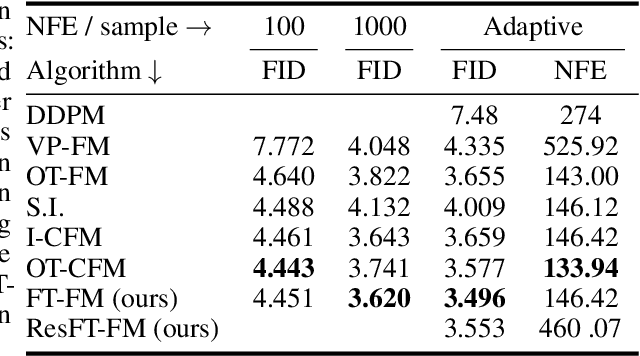


Abstract:Flow Matching (FM) algorithm achieves remarkable results in generative tasks especially in robotic manipulation. Building upon the foundations of diffusion models, the simulation-free paradigm of FM enables simple and efficient training, but inherently introduces a train-inference gap. Specifically, we cannot assess the model's output during the training phase. In contrast, other generative models including Variational Autoencoder (VAE), Normalizing Flow and Generative Adversarial Networks (GANs) directly optimize on the reconstruction loss. Such a gap is particularly evident in scenarios that demand high precision, such as robotic manipulation. Moreover, we show that FM's over-pursuit of straight predefined paths may introduce some serious problems such as stiffness into the system. These motivate us to fine-tune FM via Maximum Likelihood Estimation of reconstructions - an approach made feasible by FM's underlying smooth ODE formulation, in contrast to the stochastic differential equations (SDEs) used in diffusion models. This paper first theoretically analyzes the relation between training loss and inference error in FM. Then we propose a method of fine-tuning FM via Maximum Likelihood Estimation of reconstructions, which includes both straightforward fine-tuning and residual-based fine-tuning approaches. Furthermore, through specifically designed architectures, the residual-based fine-tuning can incorporate the contraction property into the model, which is crucial for the model's robustness and interpretability. Experimental results in image generation and robotic manipulation verify that our method reliably improves the inference performance of FM.
Open CaptchaWorld: A Comprehensive Web-based Platform for Testing and Benchmarking Multimodal LLM Agents
May 30, 2025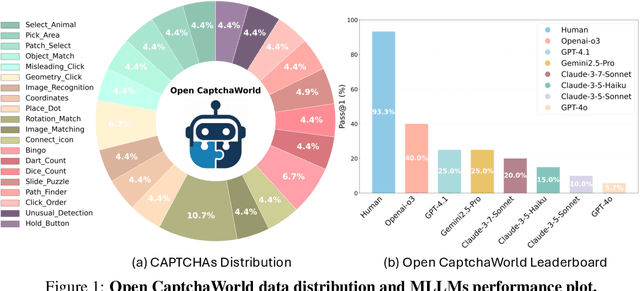
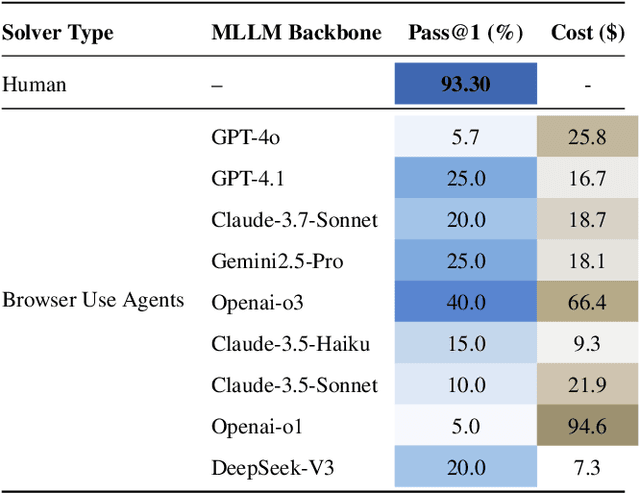
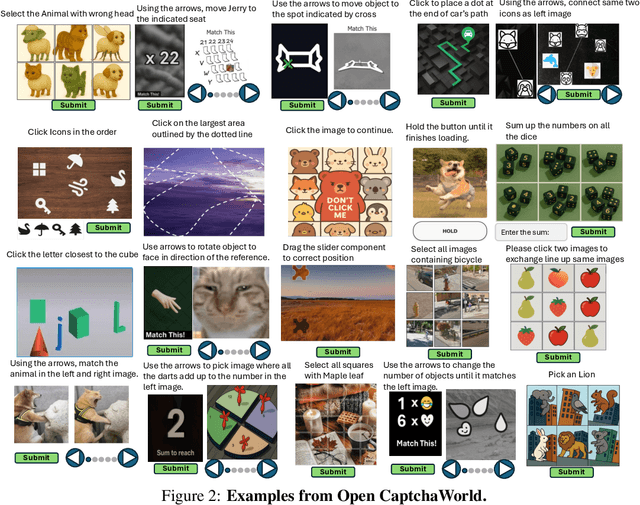
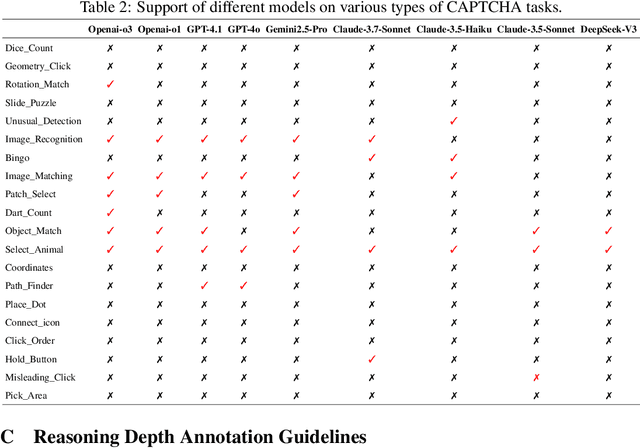
Abstract:CAPTCHAs have been a critical bottleneck for deploying web agents in real-world applications, often blocking them from completing end-to-end automation tasks. While modern multimodal LLM agents have demonstrated impressive performance in static perception tasks, their ability to handle interactive, multi-step reasoning challenges like CAPTCHAs is largely untested. To address this gap, we introduce Open CaptchaWorld, the first web-based benchmark and platform specifically designed to evaluate the visual reasoning and interaction capabilities of MLLM-powered agents through diverse and dynamic CAPTCHA puzzles. Our benchmark spans 20 modern CAPTCHA types, totaling 225 CAPTCHAs, annotated with a new metric we propose: CAPTCHA Reasoning Depth, which quantifies the number of cognitive and motor steps required to solve each puzzle. Experimental results show that humans consistently achieve near-perfect scores, state-of-the-art MLLM agents struggle significantly, with success rates at most 40.0% by Browser-Use Openai-o3, far below human-level performance, 93.3%. This highlights Open CaptchaWorld as a vital benchmark for diagnosing the limits of current multimodal agents and guiding the development of more robust multimodal reasoning systems. Code and Data are available at this https URL.
What Makes a Good Reasoning Chain? Uncovering Structural Patterns in Long Chain-of-Thought Reasoning
May 28, 2025



Abstract:Recent advances in reasoning with large language models (LLMs) have popularized Long Chain-of-Thought (LCoT), a strategy that encourages deliberate and step-by-step reasoning before producing a final answer. While LCoTs have enabled expert-level performance in complex tasks, how the internal structures of their reasoning chains drive, or even predict, the correctness of final answers remains a critical yet underexplored question. In this work, we present LCoT2Tree, an automated framework that converts sequential LCoTs into hierarchical tree structures and thus enables deeper structural analysis of LLM reasoning. Using graph neural networks (GNNs), we reveal that structural patterns extracted by LCoT2Tree, including exploration, backtracking, and verification, serve as stronger predictors of final performance across a wide range of tasks and models. Leveraging an explainability technique, we further identify critical thought patterns such as over-branching that account for failures. Beyond diagnostic insights, the structural patterns by LCoT2Tree support practical applications, including improving Best-of-N decoding effectiveness. Overall, our results underscore the critical role of internal structures of reasoning chains, positioning LCoT2Tree as a powerful tool for diagnosing, interpreting, and improving reasoning in LLMs.
A Frustratingly Simple Yet Highly Effective Attack Baseline: Over 90% Success Rate Against the Strong Black-box Models of GPT-4.5/4o/o1
Mar 13, 2025Abstract:Despite promising performance on open-source large vision-language models (LVLMs), transfer-based targeted attacks often fail against black-box commercial LVLMs. Analyzing failed adversarial perturbations reveals that the learned perturbations typically originate from a uniform distribution and lack clear semantic details, resulting in unintended responses. This critical absence of semantic information leads commercial LVLMs to either ignore the perturbation entirely or misinterpret its embedded semantics, thereby causing the attack to fail. To overcome these issues, we notice that identifying core semantic objects is a key objective for models trained with various datasets and methodologies. This insight motivates our approach that refines semantic clarity by encoding explicit semantic details within local regions, thus ensuring interoperability and capturing finer-grained features, and by concentrating modifications on semantically rich areas rather than applying them uniformly. To achieve this, we propose a simple yet highly effective solution: at each optimization step, the adversarial image is cropped randomly by a controlled aspect ratio and scale, resized, and then aligned with the target image in the embedding space. Experimental results confirm our hypothesis. Our adversarial examples crafted with local-aggregated perturbations focused on crucial regions exhibit surprisingly good transferability to commercial LVLMs, including GPT-4.5, GPT-4o, Gemini-2.0-flash, Claude-3.5-sonnet, Claude-3.7-sonnet, and even reasoning models like o1, Claude-3.7-thinking and Gemini-2.0-flash-thinking. Our approach achieves success rates exceeding 90% on GPT-4.5, 4o, and o1, significantly outperforming all prior state-of-the-art attack methods. Our optimized adversarial examples under different configurations and training code are available at https://github.com/VILA-Lab/M-Attack.
Learning to Substitute Components for Compositional Generalization
Feb 28, 2025Abstract:Despite the rising prevalence of neural language models, recent empirical evidence suggests their deficiency in compositional generalization. One of the current de-facto solutions to this problem is compositional data augmentation, which aims to introduce additional compositional inductive bias. However, existing handcrafted augmentation strategies offer limited improvement when systematic generalization of neural language models requires multi-grained compositional bias (i.e., not limited to either lexical or structural biases alone) or when training sentences have an imbalanced difficulty distribution. To address these challenges, we first propose a novel compositional augmentation strategy called Component Substitution (CompSub), which enables multi-grained composition of substantial substructures across the entire training set. Furthermore, we introduce the Learning Component Substitution (LCS) framework. This framework empowers the learning of component substitution probabilities in CompSub in an end-to-end manner by maximizing the loss of neural language models, thereby prioritizing challenging compositions with elusive concepts and novel contexts. We extend the key ideas of CompSub and LCS to the recently emerging in-context learning scenarios of pre-trained large language models (LLMs), proposing the LCS-ICL algorithm to enhance the few-shot compositional generalization of state-of-the-art (SOTA) LLMs. Theoretically, we provide insights into why applying our algorithms to language models can improve compositional generalization performance. Empirically, our results on four standard compositional generalization benchmarks(SCAN, COGS, GeoQuery, and COGS-QL) demonstrate the superiority of CompSub, LCS, and LCS-ICL, with improvements of up to 66.5%, 10.3%, 1.4%, and 8.8%, respectively.
General Time-series Model for Universal Knowledge Representation of Multivariate Time-Series data
Feb 05, 2025



Abstract:Universal knowledge representation is a central problem for multivariate time series(MTS) foundation models and yet remains open. This paper investigates this problem from the first principle and it makes four folds of contributions. First, a new empirical finding is revealed: time series with different time granularities (or corresponding frequency resolutions) exhibit distinct joint distributions in the frequency domain. This implies a crucial aspect of learning universal knowledge, one that has been overlooked by previous studies. Second, a novel Fourier knowledge attention mechanism is proposed to enable learning time granularity-aware representations from both the temporal and frequency domains. Third, an autoregressive blank infilling pre-training framework is incorporated to time series analysis for the first time, leading to a generative tasks agnostic pre-training strategy. To this end, we develop the General Time-series Model (GTM), a unified MTS foundation model that addresses the limitation of contemporary time series models, which often require token, pre-training, or model-level customizations for downstream tasks adaption. Fourth, extensive experiments show that GTM outperforms state-of-the-art (SOTA) methods across all generative tasks, including long-term forecasting, anomaly detection, and imputation.
Dataset Distillation via Committee Voting
Jan 13, 2025Abstract:Dataset distillation aims to synthesize a smaller, representative dataset that preserves the essential properties of the original data, enabling efficient model training with reduced computational resources. Prior work has primarily focused on improving the alignment or matching process between original and synthetic data, or on enhancing the efficiency of distilling large datasets. In this work, we introduce ${\bf C}$ommittee ${\bf V}$oting for ${\bf D}$ataset ${\bf D}$istillation (CV-DD), a novel and orthogonal approach that leverages the collective wisdom of multiple models or experts to create high-quality distilled datasets. We start by showing how to establish a strong baseline that already achieves state-of-the-art accuracy through leveraging recent advancements and thoughtful adjustments in model design and optimization processes. By integrating distributions and predictions from a committee of models while generating high-quality soft labels, our method captures a wider spectrum of data features, reduces model-specific biases and the adverse effects of distribution shifts, leading to significant improvements in generalization. This voting-based strategy not only promotes diversity and robustness within the distilled dataset but also significantly reduces overfitting, resulting in improved performance on post-eval tasks. Extensive experiments across various datasets and IPCs (images per class) demonstrate that Committee Voting leads to more reliable and adaptable distilled data compared to single/multi-model distillation methods, demonstrating its potential for efficient and accurate dataset distillation. Code is available at: https://github.com/Jiacheng8/CV-DD.
ICODE: Modeling Dynamical Systems with Extrinsic Input Information
Nov 21, 2024



Abstract:Learning models of dynamical systems with external inputs, that may be, for example, nonsmooth or piecewise, is crucial for studying complex phenomena and predicting future state evolution, which is essential for applications such as safety guarantees and decision-making. In this work, we introduce \emph{Input Concomitant Neural ODEs (ICODEs)}, which incorporate precise real-time input information into the learning process of the models, rather than treating the inputs as hidden parameters to be learned. The sufficient conditions to ensure the model's contraction property are provided to guarantee that system trajectories of the trained model converge to a fixed point, regardless of initial conditions across different training processes. We validate our method through experiments on several representative real dynamics: Single-link robot, DC-to-DC converter, motion dynamics of a rigid body, Rabinovich-Fabrikant equation, Glycolytic-glycogenolytic pathway model, and heat conduction equation. The experimental results demonstrate that our proposed ICODEs efficiently learn the ground truth systems, achieving superior prediction performance under both typical and atypical inputs. This work offers a valuable class of neural ODE models for understanding physical systems with explicit external input information, with potential promising applications in fields such as physics and robotics.
Mitigating the Language Mismatch and Repetition Issues in LLM-based Machine Translation via Model Editing
Oct 09, 2024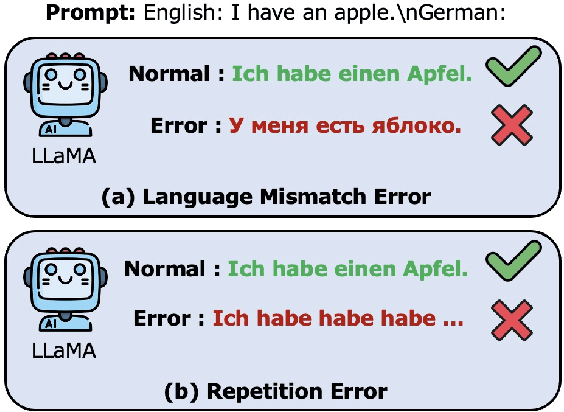

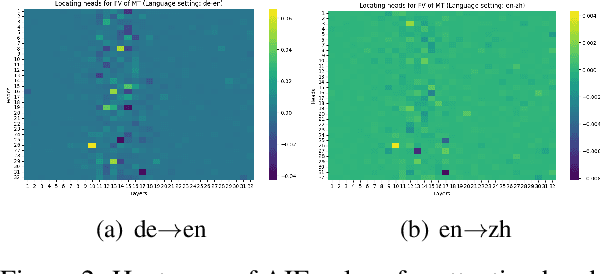

Abstract:Large Language Models (LLMs) have recently revolutionized the NLP field, while they still fall short in some specific down-stream tasks. In the work, we focus on utilizing LLMs to perform machine translation, where we observe that two patterns of errors frequently occur and drastically affect the translation quality: language mismatch and repetition. The work sets out to explore the potential for mitigating these two issues by leveraging model editing methods, e.g., by locating Feed-Forward Network (FFN) neurons or something that are responsible for the errors and deactivating them in the inference time. We find that directly applying such methods either limited effect on the targeted errors or has significant negative side-effect on the general translation quality, indicating that the located components may also be crucial for ensuring machine translation with LLMs on the rails. To this end, we propose to refine the located components by fetching the intersection of the locating results under different language settings, filtering out the aforementioned information that is irrelevant to targeted errors. The experiment results empirically demonstrate that our methods can effectively reduce the language mismatch and repetition ratios and meanwhile enhance or keep the general translation quality in most cases.
Interpretable Catastrophic Forgetting of Large Language Model Fine-tuning via Instruction Vector
Jun 18, 2024



Abstract:Fine-tuning large language models (LLMs) can cause them to lose their general capabilities. However, the intrinsic mechanisms behind such forgetting remain unexplored. In this paper, we begin by examining this phenomenon by focusing on knowledge understanding and instruction following, with the latter identified as the main contributor to forgetting during fine-tuning. Consequently, we propose the Instruction Vector (IV) framework to capture model representations highly related to specific instruction-following capabilities, thereby making it possible to understand model-intrinsic forgetting. Through the analysis of IV dynamics pre and post-training, we suggest that fine-tuning mostly adds specialized reasoning patterns instead of erasing previous skills, which may appear as forgetting. Building on this insight, we develop IV-guided training, which aims to preserve original computation graph, thereby mitigating catastrophic forgetting. Empirical tests on three benchmarks confirm the efficacy of this new approach, supporting the relationship between IVs and forgetting. Our code will be made available soon.
 Add to Chrome
Add to Chrome Add to Firefox
Add to Firefox Add to Edge
Add to Edge